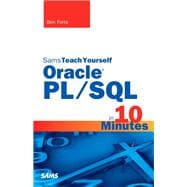Covers Oracle DBMS versions 10, 11, 12, and XE
Sams Teach Yourself Oracle PL/SQL in 10 Minutes offers straightforward, practical answers when you need fast results. By working through the book’s 26 lessons of 10 minutes or less, you’ll learn what you need to know to take advantage of Oracle’s PL/SQL language.
This handy pocket guide starts with simple data retrieval and moves on to more complex topics, including the use of joins, subqueries, regular expression and full text-based searches, stored procedures, cursors, triggers, table constraints, and much more.
10 minutes is all you need to learn how to...
- Use PL/SQL in the Oracle environments and tools
- Construct complex PL/SQL statements using multiple clauses and operators
- Retrieve, sort, and format database contents
- Pinpoint the data you need using a variety of filtering techniques
- Use string, date-time, and math functions to manipulate your data
- Join two or more related tables
- Insert, update, and delete data
- Create and alter database tables
- Work with views, stored procedures, cursors, triggers, and more








